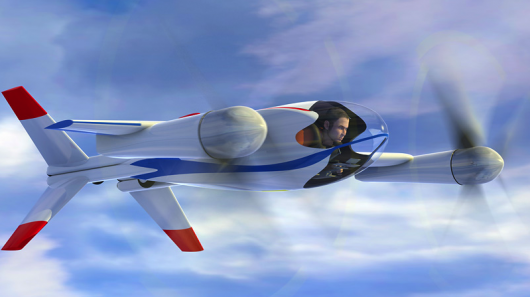NASA Puffin personal electric aircraft concept
By Jeff Salton
20:25 April 13, 2010

Be honest. Who hasn’t dreamed about flying in their own personal aircraft? NASA aerospace engineer Mark Moore moved his dreams one step closer to reality by devising this concept – the Puffin personal air vehicle. It’s a vertical take-off and landing tail-sitter that has generated quite a lot of interest from those inside and outside of NASA. It’s definitely a weird-looking craft, with a tail that splits into four "legs" that serve as landing gear. It lifts off like a helicopter, hovers, and then leans forward to fly horizontally with the pilot lying down like in a hang-glider.
The Puffin, if ever built, would be an electric-powered, 12-ft (3.7m) long, 14.5-ft (4.4m) wingspan personal air vehicle. It evolved as part of Moore’s coursework for his doctoral degree. NASA then paid for much of the research to devise how the Puffin could actually fly. Moore is a nationally recognized expert on personal air vehicles and other small aircraft systems.
The proposed aircraft would be small and very lightweight - about 300lbs (136kg) empty weight, plus another 100lbs (45kg) of battery and 200lbs (91kg) for the pilot or payload. To get off the ground, the Puffin would be propelled by 60hp of electric motors, designed to still be able to produce the required power to hover even if any two of the powertrain components on either side failed.
To take in the views on offer (or complete a mission), the Puffin would have a top speed of 150mph (241kph), but could cruise more efficiently at lower speeds. Current battery technology dictates the range would be around 50 miles (80km) before the Puffin would be looking for a safe place to land.
Why is it called Puffin? "If you've ever seen a puffin on the ground, it looks very awkward, with wings too small to fly, and that's exactly what our vehicle looks like," Moore told Scientific American.
Moore adds that the puffin is known as an environmentally-friendly bird, because it hides its poop, and the vehicle is environmentally-friendly because it essentially has no emissions. Also, puffins tend to live in solitude and this is a one-person vehicle.
The National Institute of Aerospace hopes to fly a remote control one-third size model to test whether Moore’s academic studies are right, and in particular, if the Puffin can move from hover mode to forward flight.

Copyright © gizmag 2003 - 2010 To subscribe or visit go to: http://www.gizmag.com